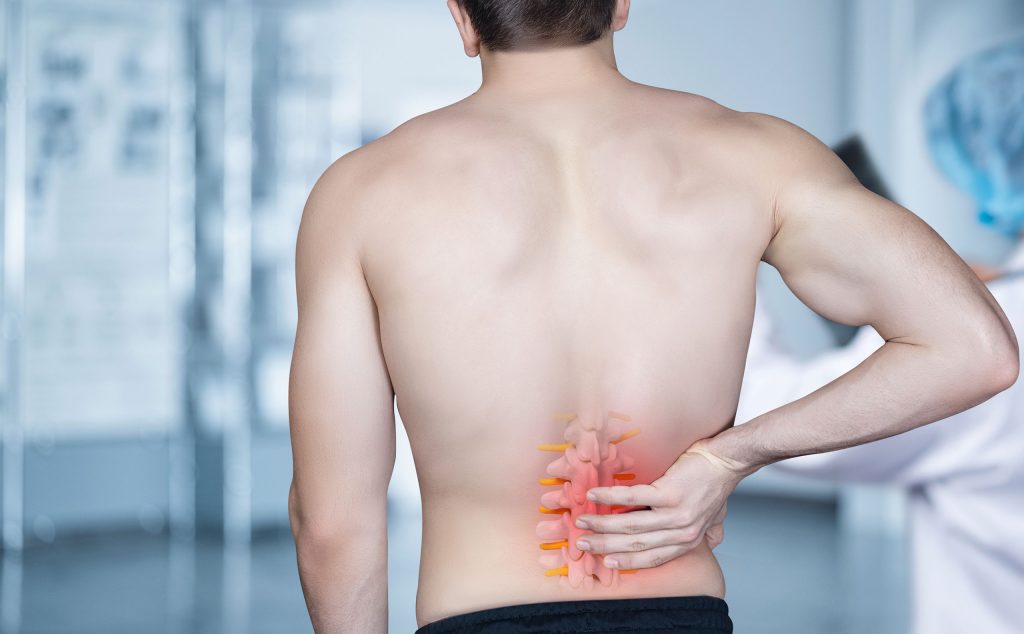The spine is made up of 3 segments, which are made up of seven cervical vertebrae, 12 thoracic vertebrae, five lumbar vertebrae, five sacral vertebrae, and 4 coccygeal vertebrae, being a total of 33 vertebrae. It also has intervertebral discs, muscles, and ligaments that together help movement.
The spine supports the head, shoulders, and upper body, also offering the necessary support to stay upright, the flexibility to lean or turn, and protect the spinal cord.
Being such a complex part of the body, several problems can alter its structure or injure the vertebrae and tissue. These injuries frequently cause pain or limit movement.
Given the existence of different spine diseases, there are also different procedures to treat them.
Diseases that affect the spine
Facet arthropathy
At the front of the spine are the vertebrae, while at the back are joints, muscles, and ligaments. The joints, known as facet joints, allow a controlled range of movement in the spine.
Wear is caused due to the inappropriate or excessive use of the joints, which translates into pain when making movements or changing position. It can also cause instability, resulting in abnormal movement in the spine.
Neck pain
Any pain located in the cervical region is known as neck pain, and this symptom can be caused by a wide variety of diseases, the most frequent being cervical facet arthropathy, herniated disc, whiplash, post-traumatic neck pain, or cervical sprain, as well as cervical spondylotic myelopathy.
Any type of neck pain should be evaluated by a neurosurgeon or orthopedist specializing in spinal surgery.
Cervicobrachial syndrome
The presence of pain in the cervical region that extends to the shoulders, arms, or upper back, as a result of the involvement of the cervical nerve roots that make up the brachial plexus, is known as cervicobrachial syndrome.
It is usually due to compression of the nerve root due to a herniated disc where the root emerges from the spine to go to the upper limb. Being a very common problem, it is a frequent cause of decreased quality of life and disability.
Narrow cervical canal
Disease in which the canal through which the spinal cord and nerve roots pass is reduced due to degeneration of the intervertebral disc, facet joints, thickening of the ligamentum flavum or ossification of the posterior longitudinal ligament.
This reduction produces affects the nerve roots due to an increase in the pressure of the fluid that surrounds them and could even affect the spinal cord.
Among the symptoms that may appear is weakness in the upper limbs, weakness in the limbs that could lead to quadriplegia or even respiratory distress due to phrenic nerve involvement.
Narrow lumbar canal
The canal through which the spinal cord and nerve roots pass is reduced due to degeneration of the intervertebral disc, facet joints, and thickening of the ligamentum flavum. Affecting the nerve roots due to an increase in the pressure of the fluid that surrounds them and patients may suffer from symptoms such as pain, numbness, or weakness when walking. Although sitting for a couple of minutes usually improves, in severe cases, it can result in urinary incontinence.
Adult scoliosis
It is one of the most complex diseases in the spine and is characterized by a progressive deformity in the spine, which is usually accompanied by a variety of other associated disorders such as herniated discs, facet arthropathy, or narrow lumbar canal, among others. For its treatment, advanced techniques in spinal surgery are necessary.
Juvenile scoliosis
Spinal deformity that occurs early in life and can progress rapidly to compromise the abdominal or thoracic structure, due to marked and excessive deformity. Like adult scoliosis, its treatment requires advanced techniques in spine surgery, aimed at avoiding complications.
Spondylolisthesis
This disease occurs when one vertebra slides over another, a movement considered abnormal. Said movement is accompanied by a deformity in the spine, with loss of normal alignment and compression of neurological structures, such as nerve roots or even the spinal cord, in more severe cases.
For its treatment, a high knowledge of the biomechanics of the spine, the neurological structures, and of the joints involved is necessary.
Trauma or osteoporotic fractures of the spine
They are a frequent cause of consultation for spine surgery. Traumatic fractures are generally due to high-impact accidents such as falls or car accidents and have a high risk of permanent sequelae.
While osteoporotic fractures are due to minor traumas or even minor efforts such as coughing, sneezing, lifting, or carrying an object, they derive from the loss of calcium in the vertebral bodies.
Due to the wide variety of fractures, their treatment is different, seeking to perform less invasive treatments and with faster recoveries.
Herniated discs
The intervertebral discs made up of a gelatinous core and a fibrous ring, serve as shock absorbers for the weight that supports the spine. Together with the joints, ligaments, and vertebral muscles, they allow movement in different directions.
Its wear occurs as a normal aging process and derives from the stress caused by walking upright, in many cases this process is accelerated by being overweight, high-impact sports like jogging, running, or weightlifting, smoking, and by individual genetics.
Disc hernias can be asymptomatic or cause pain in the lumbar, cervical, or thoracic region. Also, a feeling of numbness, tingling, weakness, or pain in the limbs can be a symptom of this disease.
If symptomatic herniated discs do not improve with the use of painkillers, invasive procedures or surgery may be required to eliminate or reduce symptoms and improve the patient’s quality of life.
Craniocervical junction instability
The junction between the skull and the first two cervical vertebrae is known as the craniocervical junction, which has the special quality of having a high range of motion, unlike the rest of the joints of the spine. For this same reason, it is an area of particular concern when there is a disease that affects safe ranges of motion.
In the event of craniocervical junction instability, the patient will be exposed to serious sequelae that could endanger their life, so attention to this area of the body is essential and a priority.
Low back pain
Low back pain occurs when there is pain in the lumbar region, made up of the back and waist. It frequently affects the buttocks and thighs and occurs after making some great physical effort in an inappropriate posture
It appears suddenly with pain in the lumbar region that increases when bending over or getting up and diminishes when being at rest.
Sciatica
It is the presence of pain in the lumbar region that extends towards the leg, due to sciatic nerve involvement or of its roots. Involvement that is usually due to compression of the nerve root by a herniated disc where the root emerges from the spine and goes to the leg.
It is a very common problem that decreases the quality of life and could even cause a disability in movement.
Congenital malformations including tethered cord
Malformations that can vary and include tethered cord, neuronal migration defects such as myelomeningocele or meningocele; deformities due to the absence or inadequate formation of the spine, including spina bifida occulta, diastematomyelia or spinal deformity.
As these pathologies appear very early in the life of patients, they seriously affect their quality of life.
Cervical spondylotic myelopathy
It is characterized by compression of the spinal cord and cervical nerve roots, derived from surrounding structures such as the intervertebral disc that is usually calcified, forming bone peaks; also facet joints thickening or posterior longitudinal ligament ossification and thickening of the ligamentum flavum.
Some symptoms may be weakening of the upper limbs or even the lower limbs, in severe cases difficulty speaking and breathing, and they could also be unable to move the limbs.
Cervical, lumbar, or thoracic radiculopathy
It causes pain or weakness in the nerve of the cervical, lumbar, or thoracic region. It is related to the presence of a herniated disc that compresses the nerve root where it leaves the spine; to a lesser extent, it may be due to tumors or viral infections, among other causes.
Spine or spinal cord tumors
Although spinal tumors are an infrequent cause of consultation, it is very important to check them based on their prognosis. Most spinal tumors are metastases from cancers in other organs such as the prostate, breast, or lung, among others; but there are also primary tumors of bone origin that can occur, such as chordomas.
On the other hand, there could be tumors of the central nervous system, including astrocytomas or ependymomas, and of the peripheral nervous system with schwannomas or tumors of the nerve sheath.
In most of the previously mentioned disorders, their treatment requires timely surgery or advanced techniques that allow restoring the alignment of the spine and maintaining its strength. Therefore, timely consultation with a neurosurgeon or an orthopedic specialist in spine surgery is recommended for a timely prognosis.
At ABC Medical Center, we have state-of-the-art technology that allows us to solve, through minimally invasive techniques, pathologies that include deformities, tumors, fractures, degenerative diseases such as herniated intervertebral discs and spinal stenosis in the cervical, thoracic, and lumbar regions, as well as in the craniocervical and lumbopelvic junctions.
At ABC Medical Center’s Neurology Center, we can provide you with specialized care. Contact us!
Fuente
Dr. José Alberto Israel Romero Rangel – neurosurgery specialist at ABC Medical Center.
https://orthoinfo.aaos.org/es/diseases–conditions/conceptos-basicos-de-la-columna-spine-basics/
https://medlineplus.gov/spanish/spineinjuriesanddisorders.html
https://www.imss.gob.mx/salud-en-linea/lumbalgia



